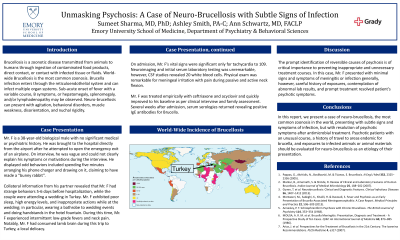Infectious Disease and HIV Psychiatry
(080) Unmasking Psychosis: A Case of Neuro-Brucellosis with Subtle Signs of Infection


Sumeet Sharma, MD, PhD
Psychiatry Resident
Emory University School of Medicine
Atlanta, Georgia
Ann Schwartz, MD, FACLP
Vice Chair of Education; Residency Training Director
Emory University School of Medicine
Tucker, Georgia
Ashley K. Smith, MMSc, PA-C
Physician Assistant
Grady Hospital
Atlanta, Georgia
Presenting Author(s)
Co-Author(s)
Background & Significance:
Brucellosis is a zoonotic disease transmitted from animals to humans through ingestion of contaminated food products, direct contact, or contact with infected tissue or fluids. Brucella infection targets the reticuloendothelial system and presents non-specifically. Neuro-brucellosis can present with agitation, behavioral disorders, psychosis, muscle weakness, disorientation, and neck rigidity. We present a case of a patient presenting with a first episode of psychosis who was found to have serum positive for anti-brucella IgM and clinical response to antimicrobial treatment.
Case:
Mr. F is a 38-year-old biological male with no past medical or psychiatric history admitted to the medicine service after a 1-week history of bizarre behavior. Psychiatry was consulted to assess for a primary psychotic disorder contributing to the patient’s presentation.
Mr. F was brought to the hospital directly from the airport when he attempted to open the emergency exit of the airplane and was escorted to an ambulance by security. The patient was traveling back from a wedding in Turkey, where he had been for the last two weeks. On interview, the patient was vague and could not pinpoint the onset of his symptoms or describe motivations for his bizarre behavior.
Collateral was obtained from patient’s partner who had been traveling with him. Per report, Mr. F began to exhibit odd behaviors 5-6 days prior to hospital presentation including poor sleep, high levels of energy, and bizarre behaviors including coming to wedding events in a bathrobe, doing handstands at inappropriate places and times, and standing in the hotel fountain fully dressed. History regarding exposures revealed that patient had ingested lamb brain, a delicacy, during his time in Turkey.
Patient’s vital signs were significant only for tachycardia on admission. Neuroimaging and serum laboratory testing was unremarkable, however, initial CSF studies revealed 20 white blood cells. Physical exam was remarkable for meningeal irritation with pain during passive and active neck flexion. Patient was treated empirically with ceftriaxone and acyclovir and quickly improved to his baseline as per clinical interview and family assessment. Several weeks after admission, serologies returned revealing positive IgE antibodies for Brucella.
Discussion:
The prompt identification of reversible causes of psychosis is of critical importance to preventing inappropriate treatment courses. In this case, the patient presented with minimal signs and symptoms of meningitis or infection, however, careful history of exposures, contemplation of abnormal lab results, and prompt treatment resolved his psychotic symptoms.
Conclusion/Implications:
In this report we present a case of neuro-brucellosis, the most common zoonosis in the world, presenting with subtle signs and symptoms of infection, but with resolution of psychotic symptoms after prompt antimicrobial treatment. Psychotic patients with an unusual course, a history of travel to areas endemic for brucella, and exposures to infected animals or animal materials should be evaluated for neuro-brucellosis as an etiology of their presentation.
References:
Guven T, et al. Neurobrucellosis: Clinical and Diagnostic Features. Clinical Infectious Diseases 2013;56:1407–1412.
Obuaya CC, et al. Brucella-Induced Acute Psychosis: A Novel Cause of Acute Psychosis. Case Reports in Infectious Diseases 2021;6649717.
Presentation Eligibility: Not previously published or presented.
Diversity, Equity, and Inclusion: This case impacts those who live in or visit areas outside of the United States. World-wide Brucellosis is the most common zoonosis, with high incidence in the Mediterranean basin countries, Middle East, Central Asia, China, India, sub-Saharan Africa, and parts of Mexico and Central America, therefore may impact marginalized communities.

